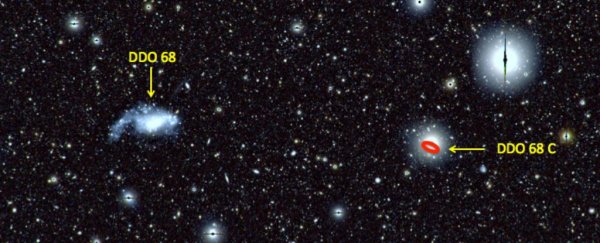For the first time, astronomers have witnessed a small dwarf galaxy forming an even tinier galaxy, confirming the idea that galaxies of any mass can accrete – or bring together – smaller galaxies.
"In other words, not only massive bodies cannibalise smaller ones that happen to lie in their surroundings, but the same appetite and digestion capabilities can be found in the smaller ones," says team member Monica Tosi, from the Italian National Institute of Astrophysics (INAF).
Understanding how these ultra-tiny galaxies form and then combine into larger galaxies will hopefully enable researchers to better understand how our galaxy – and the Universe as a whole – came to look the way it does.
To make their observation, the team used the Large Binocular Telescope (LBT) in Arizona to study a dwarf galaxy known as DDO 68 that measures only 100 million solar masses, which is only one-thousandth the mass of the Milky Way.
While examining DDO 68, the team found that there were actually a bunch of super-small galaxies forming around it via the process of accretion.
This happens when matter – dust and other space debris – gets pulled together by the gravity of a galaxy, causing a new, smaller galaxy to form. As the new galaxy gets larger, it will likely be 'eaten' by the galaxy that accreted it.
Lead researcher Francesca Annibali says what they saw reminded them of a quote by Jonathan Swift:
"'So, naturalists observe, a flea has smaller fleas that on him prey; and these have smaller still to bite 'em; and so proceed ad infinitum.' It turns out that even the smallest of galaxies feed on companions that are even smaller, and so our paper bears that quote in its title."
Over time, dwarf galaxies will consume enough smaller 'flea' galaxies to become full-fledged galaxies like the Milky Way.
This process has been predicted by computer models for some time. Now, the team was finally able to verify the model by observing it happening in the night sky.
"It is very interesting to discover that a system whose gravitational potential is too low to retain ejecta from supernovae is still capable of attracting and accreting smaller galaxies," Tosi said.
"Specific dynamical and hydrodynamical studies are necessary to understand what main mechanisms are at play here."
Guys, we've got another astronomical mystery on our hands here.
The team's findings have been published in The Astrophysical Journal.
